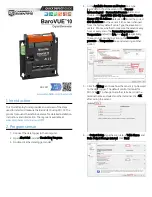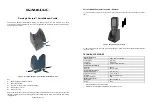
Installation and Setup
X-320M™ User's Manual
the humidity
-
1-Wire Bus:
This is used if the connected sensor uses the 1-Wire Bus Protocol to measure
temperature
-
Rmt Analog 1-4:
This option is used if the connected sensor is an analog sensor that is
being read from a remote Analog device, such as another X-320™ or Analog Module.
1-Wire Address (only shown if 1-Wire Bus is selected in Sensor Connection)
Each 1-Wire sensor comes from the factory with a unique, non-changeable address. When the
Humidity
tab is selected, X-320M™ scans the bus for sensors. The addresses of the sensors that
are found on the bus are listed in the drop-down list.
Once a sensor is found on the bus, select the appropriate sensor address from the drop-down list to
enable that sensor for humidity measurement.
Note: When the Davis Adapter Kit is used with the Davis Instruments ISS, the same 1-Wire address
will be used for both temperature and humidity. This is the only case when a 1-wire address is
shared.
Slope
In many cases, the inputs must be scaled to represent “real-world” measurements. X-320M™ reads
the “raw” value from each input, and calculates the number that represents the “real-world”
measurement that the user is actually interested in. This real-world value (referred to as the “Scaled
Value” in this manual) is calculated using the following linear formula:
Scaled Value = Slope * Input + Offset
The Scaled Value is displayed on the
Status Page.
It is also used to determine alarm conditions,
and is shown in email messages.
“Slope” in the formula above is provided by the user and is entered in this field. The value is used to
scale the input to the range of detected condition.
The default value for this field is
1
.
When the Slope is set to 1 and Offset is 0 (default values), the Scaled Value equals the Input Value.
Offset
The “Offset” is used for the “zero” measurement. The default value for this field is
0
. When both the
slope and offset are set to their default values, the Scaled Value equals the Raw Input.
Units
The units used for humidity is set to %RH.
High Alarm
This setting is used to set the trigger point for the high alarm condition. The number field specifies
the humidity at which the alarm is triggered. The alarm is triggered when the sensor reading
exceeds the High Alarm Value. The default High Alarm is
20
.
Low Alarm
This setting is used to set the trigger point for the low alarm condition. The number field specifies the
humidity at which the alarm is triggered. The alarm is triggered when the sensor reading falls below
the Low Alarm Value. The default Low Alarm is
10
.
Page 72
Xytronix Research & Design, Inc.
Summary of Contents for X-320m
Page 1: ......
















































